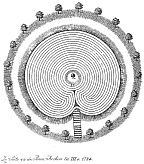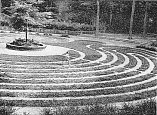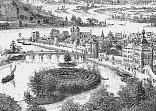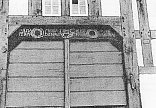
Translated from Germanien, 1940, pages 282–290.
This translation, and a translation of Sieber’s article, were published together as Troytowns in Germany, IGR Occasional Paper No. 10, Bar Hill, Cambridge, 1978.
To avoid breaking up the text, the footnotes in this Web version have been moved to the end. The footnote indicators, originally 1), 2), etc. have been changed to make them easier to click on.
The peculiar numbering of the figures (2, 1, 6, 5, 3, 4, 7) follows the original.
{3}
TREEDANCE AND TROYTOWN
The rare and remarkable Troytowns have in recent years often attracted the attention of researchers. For the most part they have been identified as the sites of ritual games; their winding paths as the routes cf dances, and at the same time an image or symbol of the Sun’s course, or of a lindworm or dragon coiled round a central point, Now the real “worm shape”, the spiral, is very rare both in existing monuments of this kind and in those that are only preserved in pictures, for the kidney-shaped layout of the paths so typical of all Troytowns cannot be said to be wormlike or snakelike, especially when the turnings are very numerous, as is clearly shown for instance in the old picture of the Windelbahn at Stolp.

Fig. 2
Moreover it is strange that the other aspect of this interpretation of the Troytcwns, namely the dance and its relation
to the singular twists and turns of the dancing-place, has until now not been taken into consideration. Plassmann is as
far as I can see the only person to have referred the dance of the butchers’ guild back to such a labyrinth dance
(Germanien, 1939, 113ff) making use of the external form of this Shrove Tuesday dance as shown in the Schembart
book. Now a treatment of Troytowns as dance paths yields important information, which places the custom in a previously
known context, covers other customs of the kind, and thus allows a clear interpretation of the subject.
In our investigation it seems useful not to begin with the groundplans, which only give the boundaries or surrounds, but
with the track of a dancer in one of these Troytowns. Let us take first the Windelbahn at Stolp, where according to an
engraving and description of 1784 the dancer begins in the middle. First he describes a spiral, which circles the
centrepoint three times, all in the same direction. Then follows a curious kidney-shaped layout of the paths which if
looked at as a groundplan seems unclear and confusing. But if we consider the movements of someone dancing along the
path, we find to our surprise a similar very simple motion around the centrepoint, merely reversing its direction after
each circuit, i.e. going first clockwise then anticlockwise. Clearly the circuit is in each case as nearly complete as
possible for tracks which lie next to one another without actually crossing. The same threefold circuit in one direction
followed by several movements back and forth is clearly recognizable in the Troytown on the island of Wier. The
Wunderkreis of Kaufbeuren (n. 1) is similar. Here however there are two consecutive spirals in the middle.
The result is that when going in towards the middle this is encircled three times in one direction,
then three times in the other. Only then do we begin the several movements back and forth in the outer circles.
Apparently the old groundplan, dated 1736, of the Wheel in the Eilenreide at Hanover (n. 2)
also belongs here. It is probably not drawn quite correctly, for the
track has no beginning or end.

Fig. 1
Also, the centre in the surviving drawing is very odd with its large S-shape, and one
might suppose that the original contained a double spiral as at Kaufbeuren.
Again, Borgo (n. 3) has a similar double spiral
in the centre of the Troytown. But here we already detect a tendency towards another type, in which the centre too is
completed by a figure where the direction of motion changes after each circuit.
At Steigra, Graitschen (n. 4) and Visby, whose plans are either identical or mirror-images, one can trace a back-and-forth path in the middle going three times in each direction; to this are added three similar circuits, {4} but minus the final change in direction. Also identical or mirror-images are the labyrinths of Knossos, the Tragliatella jar, and the medieval “moon city”* of Jericho (n. 5). Here both the inside and the outside have one less back-and-forth movement than at Steigra.
* A plan of an ideal city, drawn in the shape of a half-moon [MB].
From these shapes then one can infer a dance-form which begins with three circuits of the centre, either all in the same direction or with a back-and-forth movement, and adds three or more circuits back and forth. Yet it is not clear why this round-dance should be connected with the peculiar spiral or kidney-shape, and could not take place on a simple circle, which would have its groundplan marked out by a circle of stones or some other type of round enclosure. Now this remarkable fact, that instead of a single circular path for the dance a spiral and labyrinth shape is used, has a surprising explanation, according to which it turns out to be really necessary, and this merely because of the special nature of the dance.

Fig. 6
Dances of this kind did in fact take place. Although the descriptions are unfortunately not very precise, they give us
the basic ideas with sufficient accuracy for our purpose. They are concerned with a peculiar dance round a tree in the
middle of a festival ground, this dance being usually called the “Plantanz”. In this Journal
(Germanien, 1933, 349) there was a brief account of this very ancient dance, with its deep religious
significance, in connexion with the village lime-tree. Let us extract here the parts relevant to the shape of Troytowns.
Hessler (n. 6) reports on a kermis dance in Buchonien (Fulda region)) around a tall erected spruce-tree,
which was referred to as a “lime” although botanically it is a conifer.
The procession of girls and boys, led by the mayor
holding up a staff decorated with garlands, marched three times round the “lime” tree. Then “three
rows” were danced around the tree, whilst all further dances took place in the tavern. It seems that things were
much the same at the kermis in Wolfsbehringen (n. 7).
Here in the middle of the village is a mound planted with limes and
edged with large stones. In the middle under the biggest lime-tree lies a huge stone used as a table. The procession of
dancers, led by the musicians, all the boys with rods in their hands, skip several times in a circle around the large
stone. Only then does the real dance begin, with an opening figure by the Platzmeister, whom the other couples follow.
If in these dances our first type of Troytown is to be understood, with its circuit of the inner spiral part and then three rows of the outer kidney-shaped part, in other reports we come across the Kaufbeuren layout again. Thus Wilz (n. 8) writes concerning a French Plantanz that the procession of girls and boys marches three times round the tree, then three times in the opposite direction. “In this way the area is hallowed and consecrated and everything unclean and unholy is cast out.” And here we understand why this dancing round cannot take place on a circle, for if a whole procession of dancers wants to complete the circuit as described, a double spiral as at Kaufbeuren becomes necessary. It is something different and much simpler when in the Rhön district (n. 9) the mayor first goes alone round the dancing-place “three times so and three times so”, after which all the girls and boys proceed to dance the three rows.

Fig. 5
The third kind, represented e.g. by Graitschen and Knossos, is indicated by a report from Waltrowitz in
Moravia (n. 10). “First the boys perform the so-called Rundumerdum,
that is they hold hands, form a circle round the tree,
and jump first in one direction, then in the other. Then they dance three numbers.” Undoubtedly the pair-dance,
which usually follows nowadays in the place of the three rows, is not very old. Here people dance waltzes, Scottish
{5}
dances, etc. – that is, dances which we cannot ascribe to the early times we are dealing with. Nonetheless the
threefold nature of the “rows”, which all accounts emphasize, clearly indicates a deeper origin for these
dances; in this respect it is noteworthy that the number three has survived to this day, and is performed under the
trees even where ordinary dancing for pleasure takes place in a hall. So we are probably justified in assuming that in
ancient times these three “rows” (reihen) were really round-dances (reigen) and went three
times around the tree.
Round-dances of this kind are more often mentioned.
Thus Schnitz (n. 11) reports from the Eifel region, admittedly without
specifying a particular spiral or labyrinth-shape, that the kermis dance was held in front of the church by the great
lime-tree.

Fig. 3
“Hundreds danced to the sound of a single shawm, and doubtless no dance except the ring-dance.”
Obviously a ring-dance of this length can make circuits round the central tree only in a spiral form, or if a change of
direction is to be carried out, in the characteristic kidney-shape, There is also a very nice Swiss example quoted by
Uhland (n. 12).
“One Sunday evening seven people began a ring-dance in the castle meadow at Greyerz, which did not
cease until Tuesday morning in the great market-place at Saanen, after 700 youths and girls, men and women, had allowed
themselves to be drawn in, so that the whole thing locked like a spiral ring.” If the tree as the centrepoint of
the dance is missing here, it reappears with particular force and relevance in the old processional dance at Salzsied in
Schwäbisch-Hall (n. 13).
The festival was held here every three years, on a small island shaded by limes of great
antiquity. In the middle sat the musicians beneath a large lime-tree. Fifes and drums were their instruments. Each male
dancer held his girl modestly by the finger and came no nearer to her throughout the dance. Yet this pair-dance (if the
description does not after all refer to a round-dance of several couples) cannot have been the truly characteristic one,
for later on it is reported: “The dance remained the same all the time, except that occasionally the circle
charged into a snake-like line.” It must therefore have been very similar to the dance in a long line, with its
twists and turns. Now all these examples show clearly just how spirals and circles as dance forms “can only be
understood with reference to a centrepoint” (n. 14).
They are not here an end in themselves, and have no meaning if
taken alone, but are to be understood as circuits around something. Now this “something” is often present in
the Troytowns.

Fig. 4
At Visby it is a stone, at Graitschen today it is still a small turf mound, which also appears clearly in
the municipal seal, although here it is wrongly not placed in the middle. The illustration of the medieval “moon
city” of Jericho shows a structure that can probably be interpreted as a tree, or at least a plant. In the middle
of the Troytown at Stolp stood a tree, significantly on a mound. And it is now particularly important that in a picture
of Spring by Lucas von Valckenborch, 1587, a tree stands on three steps in the middle of such a Troytown formed from
hedges. Certainly one may think of the mazes so beloved in the aristocratic garden layouts of those days, but it has
never been questioned that while these garden mazes developed richly and strangely, they nevertheless derive ultimately
from popular custom. Further the tree on three steps has been proved so clearly from countless examples to be a ritual
tree of springtime, that it need not have been explicitly assigned to this time of year in Valckenborch’s picture
for this meaning to be established. It is even more important for us that in a similar springtime picture by Hans Bol
the lime-tree on three steps is replaced by a May-tree at the centre of such a Troytown. Here there is no doubt that we
are dealing with a combination only explicable as a custom. Treedance and Troytown are therefore intimately connected,
so that it was perfectly appropriate to plant a lime-tree at the centre when laying out the Wheel in the Eilenreide, and
that the dancing-place was beneath trees at Graitschen, and near old limes at Steigra.
{6}
From all these references it is now clear that the basic explanation for the dance in the Troytown lies where Krause and
many others after him have conjectured, in May customs with the winning of the May bride beneath the May tree.

Fig. 7
And yet our discussion has shifted the emphasis somewhat.
Of outstanding importance appears to be the role of the tree, which is
honoured as a sacred tree by the threefold circuit, and which leads us back through this custom into an age which must
lie long before the May bride and the fight against the dragon, an ancient time when the tree enjoyed the highest honour
as a symbol of the world and of life. But from this viewpoint the shape of the Troytown has nothing to do with symbols
of any kind, nor with the Sun’s course nor with the lindworm. It was defined by the form of the ritual dance
around the tree, became an established dance route and therefore “holy ground”. Its simple original plan,
which we can perhaps still detect in the Wunderkreis at Kaufbeuren, because here even for the longest train of dancers
there is no end or breaking off (in Stolp or Wier only one person can begin), has undergone various changes through the
millennia: from the dancing- and festival-places, still linked to the oldest customs, of the various societies and
guilds, down to the labyrinths contrived on a drawing-board for church floors and ornamental gardens. And if Troytowns
today – strange, full of secrets, and almost extinct – maintain only a precarious existence, yet still there
live the Plantanz and its associated kermis and other tree-dances, the lime-tree still grows at the centre of the
village green in rural communities, and this and the May-tree are the centre-point of a new life for our immortal
nation.
The Appendix was not included in the IGR translation of 1978. Added to this Web version in 2012.
To the foregoing fundamental statements I would like to contribute yet another image of a Troytown, which I owe to our colleague Dr Werner Schulte (in the field). It shows the labyrinth in a highly unusual place, namely as symbol on the lintel of a farmhouse in the village of Marmeke, in the Olpe district of Westphalian Sauerland (house No. 25, dating from 1775). The symbol – for such we may call it here – is applied twice; the two executions of it vary somewhat from one another. They are set into a saying that contains the customary prayer for protection against burning: “Jesu, Maria, Josep Saget (An?): Pewar Dis Haus Fur Für und Prand”, that is, “Jesus, Mary, Joseph, say: keep this house from fire and burning”. (The apparently Upper German initial P’s probably tell us hardly anything about the author of the inscription, still less about the two symbols.) The three persons addressed are supposed themselves to speak the prayer against fire and burning.
Now are we to regard these signs as pure symbols, symbols of the sun’s course and thus good-luck signs in a general sense? I believe that in combination with the foregoing statements by Friedrich Mössinger we can establish a narrower and more specific meaning. As Mössinger mentions, in my essay on the carnival custom of the butchers’ guild (Germanien 1939, pp. 109 ff) I drew attention to the description of a custom carried out by the butchers’ guild in Münster in the 16th century during a maze dance. Now this maze dance, according to Röchell’s Münster Chronicle (ibid.), was also danced under the great courtyard door, which in those days the old Münster houses still had, like the farmhouses: “When they came in front of a butcher’s house, the lower door had to be opened to them. Then those who were on horseback stayed in the street outside the door, while the master butchers and the ‘bride’Oldest among the unmarried daughters of the guild members went in line into the house and took hold in the rings which they carried in their hands, and one pulled another after him. Then, when it came to the servants, these pulled the linking ring so that one fell this way, another that way, which caused a great deal of laughter.”
 The “lower door” is here, as I have already pointed out, the lower half of the gate leading into the hall;
it is usual in Westphalian farmhouses and is called in the dialect niendör.
And we see such a niendör in the picture from Marmeke; the upper part of the gate is closed,
while in the lower part the right half seems to be open.
We may thus probably assume that the custom of the maze dance in the lower door was not restricted to Münster
but extended throughout Westphalia as an originally rural usage.
And from here it is only a short step to assuming that the two Troytowns above the gate preserve the memory
of the maze dance that was once danced under the gate, which explains their application to this place.
They thus retain, of course, their own nature as signs of good-luck in the general sense, for the dance itself
was certainly a symbolic-traditional activity that was no doubt thought to bring good luck.
This piece of evidence, unique as far as I know, is important in that it allows symbol and custom
to be explored in a highly unusual combination.
The “lower door” is here, as I have already pointed out, the lower half of the gate leading into the hall;
it is usual in Westphalian farmhouses and is called in the dialect niendör.
And we see such a niendör in the picture from Marmeke; the upper part of the gate is closed,
while in the lower part the right half seems to be open.
We may thus probably assume that the custom of the maze dance in the lower door was not restricted to Münster
but extended throughout Westphalia as an originally rural usage.
And from here it is only a short step to assuming that the two Troytowns above the gate preserve the memory
of the maze dance that was once danced under the gate, which explains their application to this place.
They thus retain, of course, their own nature as signs of good-luck in the general sense, for the dance itself
was certainly a symbolic-traditional activity that was no doubt thought to bring good luck.
This piece of evidence, unique as far as I know, is important in that it allows symbol and custom
to be explored in a highly unusual combination.
As regards the placename Marmeke, we may add that it represents the true Sauerland development of the Middle Low German “Marenbeke” (which as Marenbach also occurs in the neighbouring mountain country); it is composed of the Old Saxon mâri, “light, shining”, and bêki, “stream”.
Plassmann.
| 1. | Wiechel, Mitteil. d. Vereins f. sächs. Volksk. 6, 1912/1916, 97. |
| 2. | K. F. Leonhardt, Sonderheft der Hannoverschen Geschichtsblätter, 1938, 52 & 63 (groundplans of 1736 & 1858). |
| 3. | Krause, Die Trojaburgen Nordeuropas, 1893, 19, Fig. 4. |
| 4. | Precisely because of the complete identity between Steigra and Visby, I would not assume (like Stief, Odal, 1936, 989) that a ring has been lost, particularly since the municipal seal shows the same shape, though admittedly not as a groundplan but as a path. |
| 5. | Leonhardt, op. cit. 59. |
| 6. | Hess. Landes u. Volkskunde 2, 1904, 351/52. |
| 7. | Witzschel, Sagen, Sitten, u. Gebräuche aus Thüringen, 1878, 331/32. |
| 8. | Bayr. Heimatschutz 24, 1928, 30ff. |
| 9. | Ztschr. d. Vereins f. hess. Gesch. u. Landeskunde, Kassel, 1864, 363f. |
| 10. | Wiener Ztschr. f. Volksk. 1937, 48ff. |
| 11. | Sitten und Sagen des Eifler Volkes 1, 1856, 47f. |
| 12. | Collected Works 3, 1866, 398. |
| 13. | Böhme, Geschichte des Tanzes in Deutschland 1, 1886; 147. |
| 14. | Hans v.d. Au, Das Volkstanzgut in Rheinfränkischen, 1939, 47. |
Added to the IGR translation of Sieber and Mössinger in 1978:
“EinEine Trojaburg in Pommern” by Siegfried Sieber – Germanien, 1936, 83–86
“Baumtanz und Trojaburg” by Friedrich Mössinger – Germanien, 1940,
282–289The Appendix on pp. 289–290 was not included in the IGR translation.
Republished by the INSTITUTE OF GEOMANTIC RESEARCH as Occasional Paper No. 10
Full address suppressed in Web version, Bar Hill, Cambridge – April 1978
Works in English include: